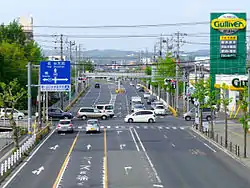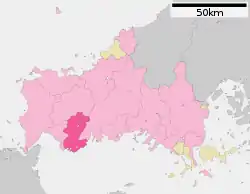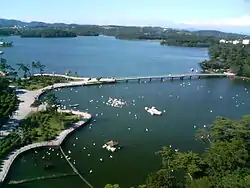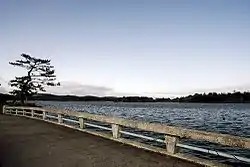Ube, Yamaguchi
Ube (宇部市, Ube-shi) is a city located in Yamaguchi Prefecture, Japan on the Seto Inland Sea. As of October 2016, the city has an estimated population of 168,398 and a population density of 590 persons per km2. The total area is 287.69 square kilometres (111.08 square miles).
Ube
宇部市 | |||||||||||
|---|---|---|---|---|---|---|---|---|---|---|---|
 Roads in Ube | |||||||||||
 Flag  Seal | |||||||||||
 Location of Ube in Yamaguchi Prefecture | |||||||||||
 Ube Location in Japan | |||||||||||
| Coordinates: 33°57′N 131°15′E | |||||||||||
| Country | Japan | ||||||||||
| Region | Chūgoku (San'yō) (San'in) | ||||||||||
| Prefecture | Yamaguchi Prefecture | ||||||||||
| Established | November 1, 1921 | ||||||||||
| Government | |||||||||||
| • Mayor | Kimiko Kubota | ||||||||||
| Area | |||||||||||
| • Total | 287.69 km2 (111.08 sq mi) | ||||||||||
| Population (October 1, 2016) | |||||||||||
| • Total | 168,398 | ||||||||||
| • Density | 590/km2 (1,500/sq mi) | ||||||||||
| Time zone | UTC+09:00 (JST) | ||||||||||
| City hall address | 1-7-1 Tokiwachō, Ube-shi, Yamaguchi-ken 755-8601 | ||||||||||
| Website | www | ||||||||||
| |||||||||||
History
The city was founded on November 1, 1921.
Previously a coal mining town, the city has developed an effective policy to improve its environment. In particular it has combated the problem of air pollution and its success in doing so saw it being recognised by the United Nations Environment Programme as among UNEP's Global 500 Roll of Honour in 1997.[1]
On November 1, 2004, the town of Kusunoki (from Asa District) was merged into Ube.
Attractions

Ube publicizes itself as "a city of greenery, flowers, and sculptures". Tokiwa Park is the centerpiece of this marketing, as it covers a large area near the center of the city and houses a large number of modern, mostly domestic sculptures on the shores of Lake Tokiwa. The sculptures can be found around the city. A sculpture competition is held biennially to provide new additions.
A well-known attraction of the park was a great white pelican called "Katta-kun", so named after his parents who were from Kolkata, India. Hatched in the park in 1985, he became famous as he began visiting schools in the vicinity. Katta-kun died in 2008, but there are a number of pelicans still residing in an enclosure there. In addition to the pelicans there were many mute swans and black swans residing there until 2011, when they were culled after an outbreak of H1N5 avian influenza. Two new mute swans were introduced in 2017.
There is a coal mining museum with a view over the city and airport.


Twin towns – sister cities
 Castellón de la Plana, Spain
Castellón de la Plana, Spain.svg.png.webp) Newcastle, Australia (1980)
Newcastle, Australia (1980) Weihai, China
Weihai, China
Festivals
Ube holds two festivals each year, one in May and the other in November featuring food stands and carnival games.
Transportation
Air
The city is served by Yamaguchi Prefecture's only airport, Yamaguchi Ube Airport, with daily flights to and from Tokyo.
Rail
- Shinkansen (bullet train)
There are no Shinkansen stations in this city. The closest Shinkansen stations are: Asa Station (Sanyo Onoda) and Shin-Yamaguchi Station (Yamaguchi)
The main train station located in 'downtown' Ube is called Ube-Shinkawa Station (Ube Line). Ube Station is farther inland and is located in a more suburban area known as Kōnan (厚南).
Education
Universities
- Yamaguchi University (national)
- School of Medicine
- Faculty of Engineering
- Ube Frontier University (private)
Primary and secondary schools
The city formerly had a North Korean school, Ube Korean Elementary and Junior High School (宇部朝鮮初中級学校).[3]
The city is home to one of the best rated English foreign language schools, Ube Gaigo Center, which is located right in the center of the city. Ube Gaigo Center is considered the number one eikaiwa in Yamaguchi prefecture and top 100 in Japan by various magazines and surveys.
Economy and industry
Ube Industries is headquartered and has major plants in Ube. Also, petroleum product company of Solato, printer machine product company of Riso Kagaku, glass product company Central Glass, semiconductor and parts product company of Renesas, pharmaceutical research and product company of Kyowa Hakko Kirin, clinical laboratory research company of Miraca Holdings are plant and factory base on Ube.
People from Ube
- Masaki Kito, attorney at law
- Naoto Kan, former prime minister of Japan
- Tadashi Yanai, founder and president of Uniqlo
- Kazuo Hara, documentary film director
- Hideaki Anno, animator and film director
- Yoji Yamada, film director
- Aimi Kobayashi, pianist
- Shunsuke Kiyokiba, pop singer (formerly vocalist of Exile)
- Satomi', pop singer
- Sayumi Michishige, pop singer (former Morning Musume member)
- Tomomi Nishimura, actress
- Kishō Taniyama, voice actor
- Hitomi Harada, voice actress and singer
- Norihiro Akimura, baseball player
- Makiko Horai, volleyball player
- Sotaro Yasunaga, soccer player
- Daisuke Tomita, soccer player
- Yuji Nakagawa, soccer player
- Ryota Takasugi, soccer player
References
- "Ube city of Japan receives UN environment award". GRID Arendal. Retrieved September 29, 2016.
- "姉妹都市・友好都市". city.ube.yamaguchi.jp (in Japanese). Ube. Retrieved April 10, 2020.
- "ウリハッキョ一覧" (Archive). Chongryon. November 6, 2005. Retrieved on October 15, 2015.
External links
| Wikimedia Commons has media related to Ube, Yamaguchi. |
- Official website (in Japanese)
 Geographic data related to Ube, Yamaguchi at OpenStreetMap
Geographic data related to Ube, Yamaguchi at OpenStreetMap